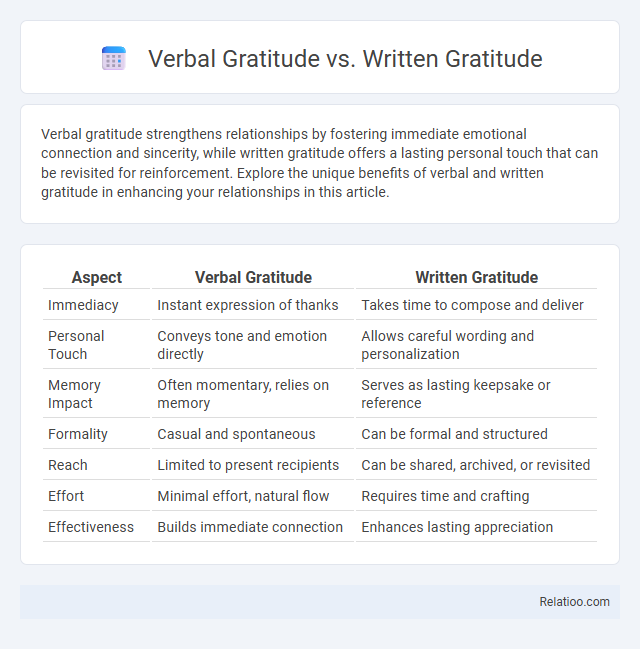Verbal gratitude strengthens relationships by fostering immediate emotional connection and sincerity, while written gratitude offers a lasting personal touch that can be revisited for reinforcement. Explore the unique benefits of verbal and written gratitude in enhancing your relationships in this article.
Table of Comparison
| Aspect | Verbal Gratitude | Written Gratitude |
|---|---|---|
| Immediacy | Instant expression of thanks | Takes time to compose and deliver |
| Personal Touch | Conveys tone and emotion directly | Allows careful wording and personalization |
| Memory Impact | Often momentary, relies on memory | Serves as lasting keepsake or reference |
| Formality | Casual and spontaneous | Can be formal and structured |
| Reach | Limited to present recipients | Can be shared, archived, or revisited |
| Effort | Minimal effort, natural flow | Requires time and crafting |
| Effectiveness | Builds immediate connection | Enhances lasting appreciation |
Introduction to Verbal and Written Gratitude
Verbal gratitude involves expressing appreciation through spoken words, creating immediate emotional connection and fostering positive interpersonal relationships. Written gratitude, by contrast, allows for thoughtful reflection and permanence, often leading to deeper, lasting impressions when you document your thanks in letters or notes. Both forms of gratitude enhance social bonds and emotional well-being, yet each serves unique contexts and personal communication styles effectively.
Defining Verbal Gratitude
Verbal gratitude involves expressing thanks through spoken words, emphasizing immediacy and emotional connection in interpersonal communication. Unlike written gratitude, which allows for thoughtful reflection and archival, verbal gratitude fosters real-time social bonding and reinforces positive interactions. Directness in verbal gratitude ensures clarity and sincerity, making the acknowledgment more impactful and personally meaningful.
Defining Written Gratitude
Written gratitude involves expressing thankfulness through written communication such as letters, emails, or notes, allowing for thoughtful reflection and permanence. This form of gratitude enhances emotional impact by providing recipients with tangible tokens of appreciation that can be revisited over time. Compared to verbal gratitude and directness, written gratitude offers a deliberate and lasting way to convey heartfelt emotions with clarity and depth.
Psychological Impact of Verbal Gratitude
Verbal gratitude has a strong psychological impact by promoting immediate emotional connection and reinforcing positive social bonds through tone and facial expression. Unlike written gratitude, spoken words convey sincerity more effectively, tapping into auditory and social cues that enhance feelings of appreciation and well-being. Direct verbal expressions of gratitude activate reward centers in the brain, boosting oxytocin levels and reducing stress, which supports mental health and fosters stronger interpersonal relationships.
Psychological Impact of Written Gratitude
Written gratitude significantly enhances psychological well-being by providing a lasting record of positive emotions that individuals can revisit, reinforcing feelings of appreciation and boosting mood over time. Unlike verbal gratitude, which can be fleeting, written expressions encourage deeper reflection and increase mindfulness, leading to reduced stress and increased life satisfaction. The cognitive process involved in composing written gratitude strengthens neural pathways related to positive thinking, making it a powerful tool for emotional resilience and mental health.
Social Contexts: When Verbal Gratitude Shines
Verbal gratitude excels in social contexts where immediate emotional connection and warmth are essential, enhancing interpersonal bonds through tone and expression. Unlike written gratitude, which allows for reflection and permanence, verbal thanks provide spontaneity that can reinforce authenticity and trust in real-time interactions. Directness in expressing gratitude further amplifies clarity and sincerity, ensuring the message resonates effectively within personal and professional relationships.
Social Contexts: The Strength of Written Gratitude
Written gratitude holds a unique strength in social contexts by providing a tangible, lasting expression of appreciation that can be revisited and shared, enhancing the emotional impact beyond the moment of acknowledgment. Unlike verbal gratitude, which is immediate and often fleeting, written gratitude offers clarity and thoughtfulness, allowing you to convey deeper emotions and reinforce social bonds over time. Directness in communication can sometimes risk being misunderstood, whereas written gratitude balances sincerity with precision, making it a powerful tool for strengthening relationships in both personal and professional environments.
Lasting Effects: Memory and Documentation
Verbal gratitude creates an immediate emotional impact that strengthens personal connections, but its effects may fade without reinforcement. Written gratitude offers lasting documentation, allowing You to revisit and reflect on positive interactions, which enhances memory retention and deepens appreciation over time. Directness in expressing gratitude ensures clarity and sincerity, boosting the authenticity of the message while supporting both immediate recognition and enduring emotional benefits.
Choosing the Right Form for the Right Moment
Verbal gratitude offers immediacy and emotional warmth, making it ideal for spontaneous expressions and personal connections. Written gratitude provides a lasting, thoughtful record that can be revisited, suitable for formal appreciation or situations requiring careful wording. Directness ensures clarity and honesty, crucial for addressing sensitive topics or when straightforward communication is necessary to avoid misunderstandings.
Integrating Verbal and Written Gratitude for Deeper Connections
Integrating verbal and written gratitude enhances emotional resonance and strengthens relationships by combining the immediacy of spoken appreciation with the lasting impact of written expression. Verbal gratitude conveys sincerity and warmth through tone and body language, while written gratitude offers a tangible, reflective message that recipients can revisit. Employing both methods creates a richer, multifaceted acknowledgment that deepens connections and fosters trust and mutual respect in personal and professional interactions.

Infographic: Verbal Gratitude vs Written Gratitude
 relatioo.com
relatioo.com